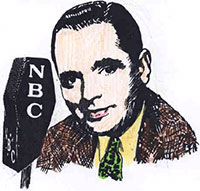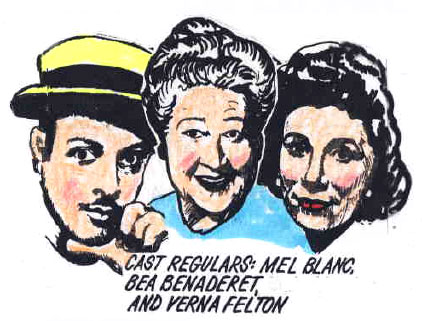|

This story was published in Radio Recall, the journal of the Metropolitan Washington Old-Time Radio Club, published six times per year.
Click here to return to the index of selected articles.
|
|
 TOMMY RIGGS AND BETTY LOU TOMMY RIGGS AND BETTY LOU
by Cort Vitty © 2007
(From Radio Recall, June 2007)
Talented comedy teams were a staple during the golden age of radio. Arguably the most unusual team in radio history consisted of only one performer; it featured a young man who had the ability to switch his voice from a deep baritone to that of a seven year old girl. The man was Tommy Riggs and he called his second voice Betty Lou Barrie. He brilliantly mastered the trick of a double voice and it propelled him into a show business career.
Tommy Riggs (without Betty Lou) was born on October 21st, 1908 and raised in Pittsburgh Pennsylvania. Tommy attended Bellefonte Academy and aspired to either be a football player or an actor. He started using the bi-vocalism as a youngster and it came quite naturally to him. Invariably whenever he impetuously changed from his normal speaking tone to that of Betty Lou, listeners would suddenly break into stitches of laughter.
 Tommy attended Brown University and later transferred to Ohio State. He delighted in teasing college chums and frat brothers with the antics of Betty Lou. During fraternity rush season a buddy called Riggs and asked if he wanted to go to dinner. Betty Lou responded and said “her father would be glad to come over.” Some of the brothers never did believe he didn’t have a daughter hidden away someplace. Tommy attended Brown University and later transferred to Ohio State. He delighted in teasing college chums and frat brothers with the antics of Betty Lou. During fraternity rush season a buddy called Riggs and asked if he wanted to go to dinner. Betty Lou responded and said “her father would be glad to come over.” Some of the brothers never did believe he didn’t have a daughter hidden away someplace.
Riggs especially delighted in using his Betty Lou voice in the seeming privacy of the team locker room; as Betty Lou piped up, his teammate’s grabbed towels and ran for cover.
He’d entertain friends at parties and often switch voices on the phone. Pressed for an explanation, Riggs would confuse people even more by saying he was not a ventriloquist. Apparently, it was a strange development in Riggs’ throat muscles that facilitated the double voice; the second was so small and lifelike that it was a perfect illusion of reality.
After graduation, Riggs worked in Pittsburgh at a filling station and did some boxing on the side. He went into the poultry business; however it soon closed as the ravages of the depression affected the economy. Without a job, he followed a lifelong ambition and secured a role as a singing master of ceremonies at a Pittsburgh vaudeville show. Next job was at WCAE Pittsburgh, where he was half of a piano team called Riggs and Moake.
The debut of Betty Lou on the air was the result of a spontaneous accident. He was rehearsing a routine with his partner when a poor script went from bad to worse. Frustrated by the lack of good material, Riggs impetuously started swearing like a sailor while using the Betty Lou voice. The program director heard the tirade and thought it was hilarious; he recommended making Betty Lou a regular part of the act.
The Tom and Betty Show debuted and became extremely popular in the Pittsburgh area. The show went on the air at 11:00 p.m., a time that caused unanticipated problems for Riggs. One night a representative from the Labor Department inquired as to why a little girl was working so late in the evening. “It took quite a while to convince him” remarked Tommy, “but at last he believed me.”
In 1933 he moved to Cleveland and station WTAM to do a fifteen minute Tommy and Betty show five days a week. This time the listeners registered dissatisfaction at his working a child so hard, when she ought to be in school. “She was too young to be working on the radio at all hours,” a concerned audience would complain. Next stop was Cincinnati and Riggs’ arrival at WLW coincided with the great Ohio River flood of 1937. Tommy was on the air literally around the clock, as Betty Lou appealed for aid on behalf of the unfortunate flood victims.
The show was heard by singer Harry Frankel, better known as “Singin Sam”, who contacted a radio agent. A recording of the act was ultimately was sent to New York and came to the attention of Rudy Vallee. This ultimately became Tommy’s big network break, garnering Riggs a 13 week engagement on the show. His contract was ultimately extended to total 49 guest appearances during 1937-38. Vallee originally introduced the act as “the man with two voices – but not a ventriloquist.” Pointing out that Riggs “does not endeavor to have his girl’s voice appear to emulate from another person or dummy.” “His natural voice shifts to that of Betty Lou in plain view of the audience.”
Betty Lou quickly became a radio phenomenon. At Radio City one day, three little girls wandered past a page boy and happened upon the studio where rehearsal was taking place. Approaching a doorman, they explained they’d come to see Betty Lou. While he thought of a logical explanation, Tommy suddenly appeared and in his best falsetto voice said “I’m Betty Lou, how are you today?’ The shocked youngsters suddenly looked disappointed, when one suddenly piped up: “I guess Mr. Vallee was telling the truth.”
Fan letters poured in. One woman begged Riggs to allow her to adopt Betty Lou. Riggs received more than 2,500 drawings of his imaginary Betty Lou. Letters accompanying the art often recommended he adopt a real life Betty Lou. Riggs held fast to his opinion that he could “better preserve the illusion” without a doll or dummy. He thought there was magic in the listeners’ imagination.
 After Vallee and Royal Gelatin, Tommy and Betty Lou secured a new series, sponsored by Quaker Oats. Tommy wrote the scripts and was essentially a straight man to the antics of Betty Lou; who simultaneously was being groomed as a possible love interest for Edgar Bergen’s Charlie McCarthy. A radio columnist remarked that such an occurrence may prompt Bergen co-star W.C. Fields to increase his daily quota of alcohol. Bergen had $10,000 worth of insurance on Charlie against fire or theft. Riggs attempted to get a similar policy on Betty Lou; however was turned down since Betty Lou was considered an “idea child” existing only in the mind and voice of Tommy Riggs. After Vallee and Royal Gelatin, Tommy and Betty Lou secured a new series, sponsored by Quaker Oats. Tommy wrote the scripts and was essentially a straight man to the antics of Betty Lou; who simultaneously was being groomed as a possible love interest for Edgar Bergen’s Charlie McCarthy. A radio columnist remarked that such an occurrence may prompt Bergen co-star W.C. Fields to increase his daily quota of alcohol. Bergen had $10,000 worth of insurance on Charlie against fire or theft. Riggs attempted to get a similar policy on Betty Lou; however was turned down since Betty Lou was considered an “idea child” existing only in the mind and voice of Tommy Riggs.
A successful 15 week engagement on the Kate Smith Show was followed by a stint as summer replacement for Burns and Allen in 1942. The series was popular enough to propel Tommy and Betty Lou into their own ensemble series. Lead roles were played by Wally Maher as Betty Lou’s boyfriend Wilber. Bea Benaderet was nosey neighbor Mrs. Wingate; Verna Felton played Mrs. McIntyre, the housekeeper for Betty and her Uncle Tommy. Anita Kurt was a vocalist and scripts were prepared by Sam Perrin, Jack Douglas and George Balzer.

The series was cut short during WWII, due to Riggs’ service aboard a Navy minesweeper in the Pacific. During his service to our country, he performed over 400 shows for servicemen. Betty Lou was the envy of Waacs, Waves and Waafs during the war, since she served in the regular Navy along with Tommy.
After the war, Riggs had stints on radio and television in Alabama. In 1946 he moved over to WTOP in Washington, replacing Ginny Simms for the summer.
Riggs first marriage was to Pittsburgh native Mary L. McIntyre. In 1948 Riggs married for a second time when he tied the knot with actress Noel Mills, who originated the role of Joan Davis on the radio series When a Girl Marries. Early in the run of the show, Mills was replaced by Mary Jane Higby, who carried the part until the conclusion of the series.
In 1950, a series entitled Tommy Riggs and Betty Lou was heard each morning from 9:45 – 10:00 a.m. on CBS. In 1955, he returned to WCAE in Pittsburgh as music director and disk jockey. He ultimately left show business in 1960 and formed the Riggs Marketing Research Company, which he operated until 1965, when poor health caused him to retire. Tommy Riggs passed away in Pittsburgh on May 21, 1967, at the age of 58. He was survived by his father James S. Riggs and his son James Riggs of Pittsburgh. The one time popularity of Tommy and Betty Lou propelled the team into two movie appearances: the Queen’s Birthday in 1936 and Good-bye Broadway in 1938.
Source Material: Encyclopedia of Old Time Radio; Chicago Tribune; Los Angeles Times; Tune In Magazine; New York Times; and Washington Post.
All illustrations (except "Betty Lou") drawn by Bobb Lynes.
|